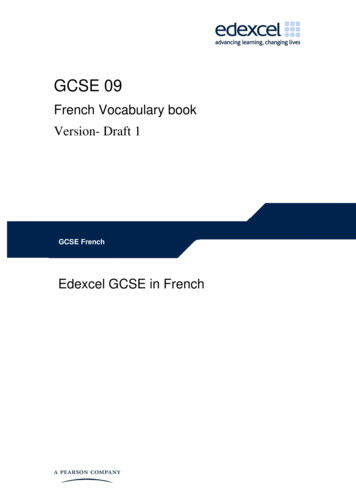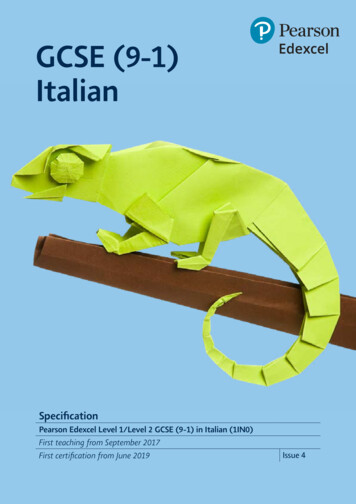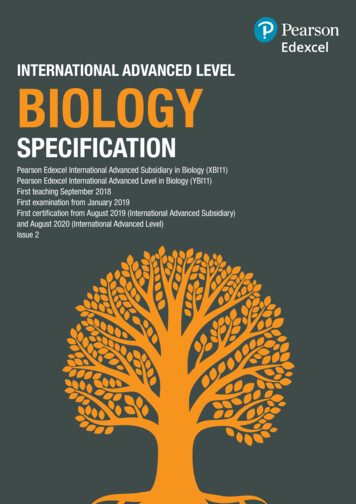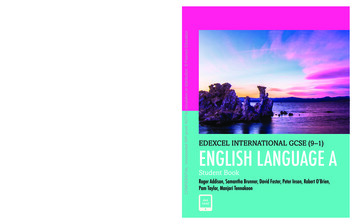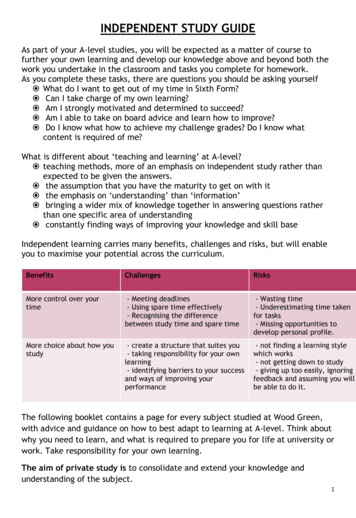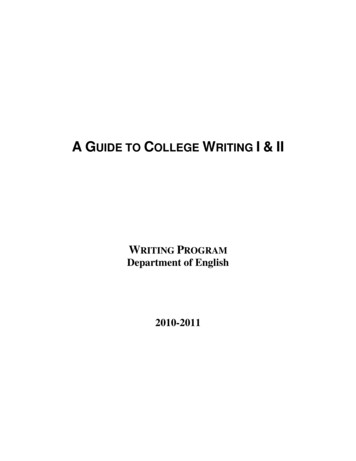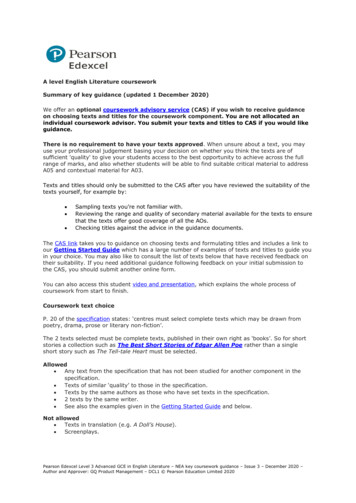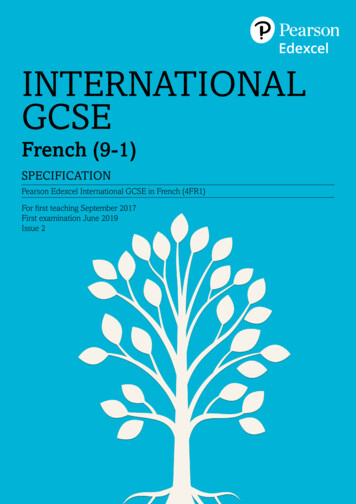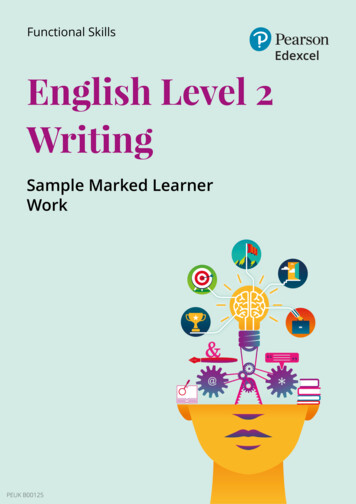
Transcription
English Level 2WritingSample Marked LearnerWork
Functional Skills Level 2 Writing:Exemplar scripts and commentariesScript 1 – Strong PassTask 1Dress codesWorking in an NHS hospital we have a dress code to follow, whether we work ina clinical or non-clinical environment. Available for all to see on our internalwebsite or Net-I as it is now known are the guidelines and policy for dress codefor all employees working within the trust.In clinical or patient facing areas, staff should abide by the following rules: Bare below the elbow, this includes no watches, bracelets, bangles orstoned rings. Short sleeves or rolled up to elbow. Neckties should be tucked into shirt or not worn at all. Shoes should be appropriate, low heeled full shoes. No excessive use of make up or perfume/aftershave.In a non-clinical area the rules are pretty much the same. Although uniformsmay not be required or necessary.The arguement for the ‘Bare Below the Elbow’ is down to infection control. Allmanor of delightful bugs and germs can linger on jewellery and watches or becarried on the sleeves of your clothing. Just imagine being treated by someonewith dirty fingernails!!However, I know by discussion with colleagues who are non-clinical that theyfeel they should be able to wear jewellery or watches if they wish too. They feelthat it has no impact on patient care.Personally having worked in both clinical and non-clinical areas I can see thereasoning behind the dress code policy. I believe that if you are a ward or clinicbased worker irrespective of whether you are a doctor, nurse or receptionist youshould abide by the bare below the elbows code. I am by no means able to giveall the reasons why this came about, but much better educated and wellinformed people came up with the reasons behind the bare below the elbowspolicy. I for one, would and did, abide by the policy. Is there a reason not too?Even working in a non-clinical area, there can still be contact with patients andvisitors to our trust. I know I’d rather see a suitably dressed member of staffthan someone who looks either untidy or like they are off out to a club!We should take pride in ourselves, we are often the first person someone mayencounter in our Trust. Why wouldn’t we want to represent our hospital in agood way?
Task 2I joined social media after being encouraged to do so by friends and family. Evennow 11 years later I still only use one social media app, I don’t get the others!Social media is great for keeping in touch with friends or family who don’t livenearby, infact it helped me reconnect with a family member who had movedaway and also some old school friends. However it can also be intrusive! Unlessyou check your privacy settings you could end up with all manor of friendrequests from people who you’ve never had any connection with. My advice is tobe wary!Social media is a great way to share photos and events and even advertise yourbusiness. But in reality if you saw some ‘friends’ outside in the real world, wouldyou speak to them?Personally I like to talk to people face to face. A big part of communicationcomes from our body language and facial expressions whilst we are talking.Chatting via social media is great to keep in touch and maintain contact but it’sno substitute for being with that person face to face. How many times has awritten message on social media been taken the wrong way or out of context?What one person will find funny will offend the next person.I think we should enjoy social media but never should it become a substitute forthe personal touch.Meeting people in the flesh is just not the same as looking at a screen.
CommentaryTask 1CompositionThe learner communicates information about dress codes with consistent clarityand in a way that is effective for purpose and audience. There is successful useof detail to address each bullet point, although there is relatively little on thearguments against dress codes.The learner writes in an appropriate style for an article and includes a heading.There is an extensive range of vocabulary and a range of sentence types,including the effective use of complex sentences. The length of the response isappropriate, but the ending is a little abrupt and so the response scores 11marks, rather than 12.Mark: 11Spelling, Punctuation and GrammarSpelling, punctuation and grammar are consistently correct and there is a widerange used. There are some slips, e.g. ‘arguement’, and the use of ‘manor’,rather than ‘manner’ and ‘too’, rather than ‘to’. There are just too many of thesefor the response to gain full marks.Mark: 8Task 2CompositionThe learner communicates ideas about social media with consistent clarity. Thereis an excellent level of detail, which is highly effective for purpose and audience.There is no set format for a web forum, but the informal and lively style used isvery effective. There is effective paragraphing and an extensive range ofvocabulary, e.g. 'intrusive'. The learner uses a range of sentences effectively,including complex sentences.Mark: 9Spelling, Punctuation and GrammarSpelling, punctuation and grammar are consistently correct. There is also animpressive range of words and punctuation used, e.g. inverted commas,exclamation marks and a full stop. There is the occasional error, e.g. ‘manor’,but the response is still accurate enough for full marks to be awarded.Mark: 6
Script 2 – Borderline PassTask 1While there are arguments for and against dress code I beleive that everyoneshould be able to express theirselve and wear/look how they want. Oneargument for dress code is that it there is a uniform/code then no body wearingit can be discriminated, for example if someone did not have very good clothesbecause they couldn’t afford it and there was someone else and they turned upwearing top of the range, branded, expensive clothes then people might havesomething to say or compare the two and make it an uncomfortable situation.The argument against dress code is obiously freedom of expression, dressing,and expressing your self how you like. I go to college and there isnt a dress codewhich is fine but when I went to school there was a very strict dress code andevery student was the same, they had to wear all the same uniform all the time,the only thing that was different was the colour of your tie depending on whathouse block you were in. So there is reason to have dress code, in school or atwork but college is a place where most people find their feet and feelcomfortable expressing who they are. Yes you should be able to wear what youwant but sometimes it is more appropriate to have a uniform/code however thatis depending on where you are, for example if you work in a tattoo/piercing shopthen having tattoos/piercings maybe even dyed hair, 95% of the time is fine butif you worked somewhere like a care home them that will most likely be deemedunacceptable. So the question is not ‘Should dress code be a thing or not?’ Itshould be, Where should a dress ocde be used?Task 2I prefer to use social media to communicate with friends and family, howeverthat may not be the case with other people. There are many, many ways tocommunicate with people such as email, writing a letter, social media, a phonecall, video chat or actually seeing and speaking to them in person.I find social media my ‘go-to’ for communication because it is easier to use, it isfast and it is also reliable, however it does have as many cons as it does pros.Some of the cons are that for alot of social media you need internet so if youdon’t have mobile data and you are out and about there isn’t always an availableinternet connnection for you to use so you may not be able to use social media.Another con is that often social media accounts can get hacked so if you are incontact with someone via social media and there account gets hacked they maynot be able to contact you to tell you theres a problem so you could loosecontact with them, but, there are pros too such as making friends. contactingeach other to make plans or even seeing things about how peoples feeling orwhat they have been doing. Obviously there are other ways of communicationbut social media is my personal favourite, whats yours?
CommentaryTask 1CompositionThe learner communicates information about dress codes reasonably clearly andprovides appropriate detail for purpose and audience, by addressing each bulletpoint.No heading is provided and paragraphs do not appear to be used. However, theresponse does have an appropriate structure, including a brief introduction and aconclusion at the end.A range of sentences is used with general accuracy, although there are errors.Register is appropriate for the task and a wide range of appropriate vocabularyis used.Mark: 7Spelling, Punctuation and GrammarSpelling punctuation and grammar are generally correct. Spelling is probably theweakest area and errors include ‘beleive’, ‘theirselve’ and ‘peircing’. However,there is also good spelling of some challenging words, such as ‘appropriate’.Punctuation and grammar are generally more accurate, although there areerrors, such as the occasional missing apostrophe. The response is sufficientlyaccurate for five marks to be awarded.Mark: 5Task 2CompositionThe learner communicates information about social media reasonably clearly.There is an appropriate level of detail for purpose and audience.There is no set format for a forum contribution, but the language and registerare appropriately informal for this type of task. Two paragraphs are used, butthe response would benefit from being broken up into more paragraphs.Language and register are appropriate for the task.Mark: 6Spelling, Punctuation and GrammarSpelling, punctuation and grammar are generally correct. As with Task 1 thereare several spelling errors including ‘alot’ and confusion between ‘there’ and‘their’, as well as accurate spelling of words like ‘obviously’. Grammaticalaccuracy is similar to Task 1, but the use of punctuation is slightly weaker, e.g.in the long sentence on the second page of the response. For this reason theresponse is placed at the lower end of the middle band.Mark: 3
Script 3 – Borderline FailTask 1is it fair to have a dress code?Dress code is a good and bad because it is good to know that you work at the abar because you would have a top to wear however it is a bad thing becauseeveryone is different, everyone has different clothing styles, piercing maybeeven tattoo. Covering up tattoos can be very tricky and even piercing. Somepeople get tattoo and percings not because they like they but because it makesthem feel themselve which should be OK to have piercing or tattoos on show in apub but if you was working as an assitant for a bit company they might not likethem on show because it is not accesable to them as people in big company’slike to be professional and smart in the work place. But telling someone to hidetheir piercing and tattoos and have a dress code is a bit much as having a dresscode is understandable in a big company but telling them to hide their tattooswhich means a lot to someone is hard because they woudn’t want to cover it upwhen it is apart of them.Is a dress code good or bad? no one could acually answer that question becausethere are too many different reason for it to be good or bad.However dress code is a really good thing depending where you work or if yourat school or college because having a dress code at college would be like schoolall over again as it would be like treating everyone like children which wouldn’tbe right, therefore if the teacher treat us like adult a dress code wouldn’t beneeded and everyone can be themselves. So dress code isn’t a good thing forcolleges.For being at work, it really depend where you are working and what you areworking as because being a bar lady you would either wear your clothes or weara top with the bars name and the logo but apart from that their isn’t anythingbad about not having a dress code for a pub. However working for a companyyou would need a dress code because then everyone would know to dressappropitely and smart, so you would cover up any tattoos and certain peircings.Task 2I use most of the apps to keep in touch with my friends and family, butsometimes that are not as good as people think because half the time they areeither updating or the app has just crashed. Some people normally start cryingabout how they cant talk to their friends because the app they are on is buggingout. Well my opinion is that teenagers should go out and meet their friends orfamily instead of staying online all the time as it isn’t good for you at all.I don’t mind social media as I use it myself but it still would be nice to go outand see friends because your getting the commication face to face which I thinkis better as people take in more.
CommentaryTask 1CompositionThe learner communicates information about dress codes reasonably clearly.Some appropriate detail is provided, although the first bullet point isn’t clearlyaddressed.An appropriate heading is used and ideas are organised into generally accurateparagraphs. There is some use of a range of sentences, but this is not alwaysaccurate and the structure can be slightly repetitive. Register is appropriate forthe task and a wide range of vocabulary is used.Mark: 7Spelling, Punctuation and GrammarWhilst spelling punctuation and grammar are generally correct, there are severalerrors, mainly in the use of grammar. These errors keep the response at thebottom of the middle band. There are tense errors, such as ‘it really depend’ and‘if you was working’ and also missing word endings, e.g. ‘Some people gettattoo’.Mark: 4Task 2CompositionThe learner communicates ideas about social media reasonably clearly andprovides some detail to support the ideas, although the second bullet point couldbe more fully addressed. The response appears to be fairly brief, but this is theshorter task and so learners are not expected to write more than about 200 to250 words.There is no set format for an internet contribution and two paragraphs are usedwith general accuracy. There is some use of a range of sentences. Register isgenerally appropriate, although there is no strong sense of this being a forumcontribution. There is a reasonable range of vocabulary, appropriate to purposeand audience.Mark: 5Spelling, Punctuation and GrammarOverall there is generally correct use of spelling, punctuation and grammar.There are several errors however, including confusion between 'your' and‘you’re, 'commication' and the use of ‘that’, rather than ‘they’ on the third line.The overall level of SPG is similar to Task 1.Mark: 3
Script 4 – Clear FailTask 1Dress codeI think wearing a dress code in a workplace should be becasue I think it is ahealth an safety in some workplace and should wear a dress code. Because youafter be presentble in a workplace.My opinion on dress code in college their shouldnt be one. Because you shouldfeel comfortable in what you are wearing but you should be wearing nice andpresntble clothes so can lead by example. But you should be wearing a DressCode in School with a logo with your school on the jumper or cardigane. Itmakes you look nice and when people look at you and you are looking nice andpresentble it shows the school is showing that has got a dress code and want toshow that the school has a policy about looking presentble. But i feel in someschools like Academy to day their is a Dress Codes from year 7 to year 11howver when you go to 6 form you after wear a shirt and tie and young womena Dress. But I feel you should be wearing the dress code and the uniforms fromyears 7 to years 11 this will show an outline of a school that there is a dresscode from when you start and when you finish.My opinions you should to the school goverment body and ask about dress codesand put your points across. And in some workplace you have agency firms whatwork for you they should be a dress code for them aswell Because you cannothave an policy on one person after where an dress code an one not.Task 2Dear Sir or MadamI use all the social media site to contact my friends and family it is realy goodwhen you talk to people your facetime people who live faraway and in somesocial media there are some parts of it what i don’t like about it some people putsome things on what is unpleasant to see witch I think is apart life However inthis day and age it is all about tecknowledge these days. I still wish you talk faceto face with people but like I said you may have some people who live farawayin anouther country but my opinion I still wish you can talk to people face toface.And in my opinion in some social media site I like to follow whats happening inthe world and stay in touch with family freinds but I must say I would prefertalking over the phone or face to face.
CommentaryCompositionThe learner communicates ideas about dress codes reasonably clearly andprovides some detail to support the ideas. The approach is quite generalhowever and there is some lack of specific information about the learner’s ownorganisation.The response has a heading and paragraphing is used with general accuracy. Arange of sentences is used, but this is only done with some accuracy. Register isgenerally appropriate for the task and there is a reasonable range of vocabulary,appropriate to purpose and audience. The response just merits the middle bandoverall.Mark: 5Spelling, Punctuation and GrammarThere is some correct use of spelling, punctuation and grammar. Errors includeinaccurate constructions such as ‘Because you after me presentable in aworkplace’, use of the lower case ‘i’ and spelling errors such as ‘aswell’.Mark: 3CompositionThe candidate communicates ideas about social media with some clarity andmakes some appropriate points.The learner begins the response with Dear Sir/Madam which is an acceptable, ifunconventional, start to a forum contribution. Two paragraphs are used, butsentence structure is weak and this impacts on the clarity of the response. Thereis some range of appropriate vocabulary and the register is appropriate forpurpose and audience. The lack of clarity places this response in the lowestband.Mark: 3Spelling, Punctuation and GrammarThere is some correct use of spelling, punctuation and grammar. There arefrequent errors including missing punctuation marks, 'realy' and 'freinds'.Mark: 2
Mark Scheme(Final)Functional Skills EnglishWriting Level 2PENW2 Set 1
Functional Skills Qualifications from PearsonFunctional Skills qualifications from Pearson, the world’s leading learning company. Weprovide a wide range of qualifications including academic, vocational, occupational andspecific programmes for employers. For further information visit our qualifications websiteat qualifications.pearson.com. Alternatively, you can get in touch with us using the detailson our contact us page.Pearson: helping people progress, everywhereOur aim is to help everyone progress in their lives through education. We believe in everykind of learning, for all kinds of people, wherever they are in the world. We’ve beeninvolved in education for over 150 years, and by working across 70 countries, in 100languages, we have built an international reputation for our commitment to high standardsand raising achievement through innovation in education. Find out more about how we canhelp you and your students at: www.pearson.com/ukAll the material in this publication is copyright Pearson Education Ltd 2019
General marking guidance All candidates must receive the same treatment. Examiners must mark the lastcandidate in exactly the same way as they mark the first. Mark schemes should be applied positively. Candidates must be rewarded for whatthey have shown they can do rather than be penalised for omissions. Examiners should mark according to the mark scheme, not according to theirperception of where the grade boundaries may lie. There is no ceiling on achievement. All marks in the mark scheme should be usedappropriately. All the marks in the mark scheme are designed to be awarded. Examiners shouldalways award full marks if deserved, i.e. if the answer matches the mark scheme.Examiners should also be prepared to award zero marks if the candidate’s responseis not worthy of credit according to the mark scheme. Where some judgement is required, mark schemes will provide the principles bywhich marks will be awarded and exemplification may be limited. When examiners are in doubt regarding the application of the mark scheme to acandidate’s response, the team leader must be consulted. Crossed-out work should be marked unless the candidate has replaced it with analternative response.Instructions to examiners:Two grids need to be applied when assessing a candidate’s response:A: composition and B: spelling, punctuation and grammar.A candidate’s composition may be appropriate for Level 2, but spelling, punctuation andgrammar have weaknesses; or a candidate may have reasonably secure spelling,punctuation and grammar but be less successful in composition. It is essential,therefore, that both marking Grids A and B are applied independently.When awarding a mark for composition (Grid A), examiners should use the first bulletpoint in each band in the mark scheme to decide on the overall level of achievement.The other three bullet points should be used to determine where best to place theresponse within the band.When awarding a mark for spelling, punctuation and grammar (Grid B), examinersshould make a ‘best fit’ judgement, using the descriptors.
Task1Indicative contentAnswers will be credited according to the candidate’s demonstration ofknowledge and understanding of the material using the indicative content andlevels descriptors below.The indicative content that follows is not prescriptive. Answers may coversome / all of the indicative content but should be rewarded for other relevantexamples.In their articles, candidates should: outline the dress code at their workplace / college / school e.g. people canwear what they like, staff are expected to wear formal office clothes to work,no visible tattoos or piercings allowed explain the arguments for and against dress codes e.g. everyone will lookprofessional, there will be less judgment/bullying if everyone is the same, itprevents people from being individual, limits personal choice give their opinions and persuade people to agree with them e.g. agree witha dress code because everyone will look smart, disagree with a dress codebecause it’s not fair that people can’t wear what they want to.(21 marks)
Mark Grid A: Composition (12 marks)0 No rewardable material.1–4 Communicates straightforward information, ideas and opinions with someclarity for purpose and audience. Organises writing using appropriate format and structure, including some useof paragraphs and cohesion, e.g. using organisational markers to someextent. Uses a range of sentences, including complex sentences, with someaccuracy. Uses language and register, including some range of vocabulary, appropriateto purpose and audience.5–8 Communicates information, ideas and opinions reasonably clearly with anappropriate level of detail for purpose and audience to an appropriate length. Organises writing using appropriate format and structure, including generallyaccurate use of paragraphs, and mostly maintaining cohesion, e.g. usingorganisational markers. Uses a range of sentences, including complex sentences, with generalaccuracy. Uses language and register, including a wide range of vocabulary,appropriate to purpose and audience.9–12 Communicates information, ideas and opinions with consistent clarity, usingdetail effectively for purpose and audience to an appropriate length. Organises writing using appropriate format and structure, including effectiveuse of paragraphs, and sustaining cohesion, e.g. using organisationalmarkers. Uses a range of sentences, including complex sentences, accuratelyand effectively. Uses language and register, including an extensive range of vocabulary,appropriate to purpose and audience.
Mark Grid B: Spelling, punctuation and grammar (9 marks)0 No rewardable material.1–3 Some use of correct grammar (e.g. subject-verb agreement, consistent useof a range of tenses, definite and indefinite articles) and modality devices(e.g. to express probability or desirability). Some correct use of a range of punctuation (e.g. colons, commas, invertedcommas, apostrophes and quotation marks). Spelling of words used in work, study and daily life, including a range ofspecialist words, is sometimes accurate.4–6 Generally correct use of grammar (e.g. subject-verb agreement, consistentuse of a range of tenses, definite and indefinite articles) and modalitydevices (e.g. to express probability or desirability). Generally correct use of a range of punctuation (e.g. colons, commas,inverted commas, apostrophes and quotation marks). Spelling of a range of words used in work, study and daily life, including arange of specialist words, is generally accurate.7–9 Consistently correct use of grammar, with occasional lapses (e.g. subjectverb agreement, consistent use of a range of tenses, definite and indefinitearticles) and modality devices (e.g. to express probability or desirability). Consistently correct use of a wide range of punctuation (e.g. colons,commas, inverted commas, apostrophes and quotation marks) withoccasional lapses. Spelling of a wide range of words used in work, study and daily life, includinga range of specialist words, is consistently accurate, with occasional lapses.
Task2Indicative contentAnswers will be credited according to the candidate’s demonstration ofknowledge and understanding of the material using the indicative content andlevels descriptors below.The indicative content that follows is not prescriptive. Answers may coversome/all of the indicative content but should be rewarded for other relevantexamples.In their contributions, candidates should: give their views on using social media to keep in touch with people e.g. quickand easy, get instant response, spend less time seeing friends in real life describe how they prefer to communicate e.g. use apps like WhatsApp,Snapchat, Messenger, like to meet up with friends in a café.(15 marks)
Mark Grid A: Composition (9 marks)0 No rewardable material.1–3 Communicates straightforward information, ideas and opinions with someclarity for purpose and audience. Organises writing using appropriate format and structure, including some useof paragraphs and cohesion, e.g. using organisational markers to someextent. Uses a range of sentences, including complex sentences, with someaccuracy. Uses language and register, including some range of vocabulary, appropriateto purpose and audience.4–6 Communicates information, ideas and opinions reasonably clearly with anappropriate level of detail for purpose and audience to an appropriate length. Organises writing using appropriate format and structure, including generallyaccurate use of paragraphs, and mostly maintaining cohesion, e.g. usingorganisational markers. Uses a range of sentences, including complex sentences, with generalaccuracy. Uses language and register, including a wide range of vocabulary,appropriate to purpose and audience.7–9 Communicates information, ideas and opinions with consistent clarity, usingdetail effectively for purpose and audience to an appropriate length. Organises writing using appropriate format and structure, including effectiveuse of paragraphs, and sustaining cohesion, e.g. using organisationalmarkers. Uses a range of sentences, including complex sentences, accuratelyand effectively. Uses language and register, including an extensive range of vocabulary,appropriate to purpose and audience.
Mark Grid B: Spelling, punctuation and grammar (6 marks)0 No rewardable material.1–2 Some use of correct grammar (e.g. subject-verb agreement, consistent useof a range of tenses, definite and indefinite articles) and modality devices(e.g. to express probability or desirability). Some correct use of a range of punctuation (e.g. colons, commas, invertedcommas, apostrophes and quotation marks). Spelling of words used in work, study and daily life, including a range ofspecialist words, is sometimes accurate.3–4 Generally correct use of grammar (e.g. subject-verb agreement, consistentuse of a range of tenses, definite and indefinite articles) and modalitydevices (e.g. to express probability or desirability). Generally correct use of a range of punctuation (e.g. colons, commas,inverted commas, apostrophes and quotation marks). Spelling of a range of words, used in work, study and daily life, including arange of specialist words, is generally accurate.5–6 Consistently correct use of grammar (e.g. subject-verb agreement,consistent use of a range of tenses, definite and indefinite articles) andmodality devices (e.g. to express probability or desirability), withoccasional lapses. Consistently correct use of a wide range of punctuation (e.g. colons,commas, inverted commas, apostrophes and quotation marks) withoccasional lapses. Spelling of a wide range of words, used in work, study and daily life,including a range of specialist words, is consistently accurate, with occasionallapses.
Mapping to Functional Skills Coverage and Range for English Level 2WritingScope of StudyText: this should include straightforward and complex texts such as articles,narratives, explanations and reports of varying lengths.Ref.Content statementCoverageNo. of%marks20Punctuate writing correctly using a wide rangeof punctuation markers (e.g. colons, commas,inverted commas, apostrophes and quotationmarks)21Use correct grammar (e.g. subject-verbagreement, consistent use of a range of tenses,definite and indefinite articles) and modalitydevices (e.g. to express probability ordesirability)2223242526Task 1Task 21542215836100Spell words u
something to say or compare the two and make it an uncomfortable situation. The argument against dress code is obiously freedom of expression, dressing, and expressing your self how you like. I go to college and there isnt a dress code which is fine but whenI went to school there was a very strict dress code and


